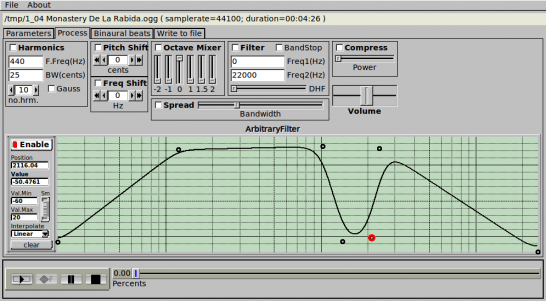Free Music Software: Developer Paul Nasca has released an updated version of Paul’s Extreme Sound Stretch, or Paulstretch, a program for stretching audio.
It is suitable for extreme sound stretching of audio and for applying special effects by spectral smoothing the sounds. It can transform any sound/music to a texture.
Version 2.1 is even more extreme and stretchier.
How stretchy is it? It can stretch your audio file up to one quintillion times ( 10^18 x ). Technically, that’s like a “bajillion” with a couple of extra zeros at the end.
If you’ve tried Paul’s Extreme Stretch, leave a comment with your thoughts on it!
New in Paulstretch 2.1:
- Added loading/saving parameters.
- Added Linux Jack support.
- Added Symmetric mode of Binaural Beats.
- Support for longer stretches – for the really patient ones – up to one quintillion times ( 10^18 x ).
- Fixed a bug which produced infinite loop at the end of some mp3 files (at playing or render).
- Fixed a bug in the mp3 reader.
- Other minor additions.
Paulstretch is open source software released under a General Public License (GPL2).
A Windows binary is available to download at Nasca’s site. The Mac version is maintained separately, here.


A one second sample stretched a quintillion times will last 31.7 billion years.
I need a larger hard drive.
We suspect their might be a practical limit to the extreme stretchiness……
+1 for featuring (and stressing) free software and GPL2.
Great piece of software, I’ve used it before and I absolutely adore it, I have noticed though, that it can sometimes leave a bit of a hissing noise(even in parts that didn’t originally have hissing) if you have part of an audio track with a sort of tape hiss.
you’d have to have an insane resolution in order for that to be useful
Wow … where has this tool been all of my life! How awesome is it to make big long evolving pad sounds from the space between the beats in your favourite tunes? What a ripper! Thank YOU!
It’s wonderful! and even so easy to use..
This is amazing if used on vocals, which are then cut. You can get some awesome dubstep-style samples this way.
would love to see an updated version… integration feature into a DAW
The parameters are easier to use in the latest version than before. Some of what appear to be artifacts (what some call the hiss, etc) can be eliminated or increased to varying degrees with some tuning.
Because the parameters can all be changed during playback, you can be more creative, especially if you use a separate audio recording application to record as you do so.
Although the guide (a separate web page) gives some idea of what they do, experimenting is a great way to learn if you have the time.
One of the most useful features (for me, at least) is the freeze option, which is part of the playback controls. Although on my computer I experience a time lag between pressing the button and the freeze starting, a bit of trial and error coupled with familiarity of the sound that I’m recording can be very useful.
The kinds of music I find best suited to use with this are instrumental, with only a few instruments, and with restrained percussion – i.e. no huge crashes on cymbals. Vocals? There’s a huge difference between changing a trained voice vs. an untrained voice; with untrained voices you can often hear the slide up and down to a pitch that doesn’t usually come with a trained voice. Autotune? yuk.